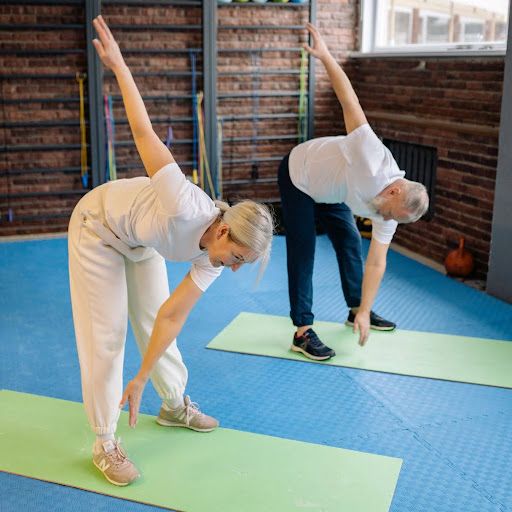This Seinfeld Star is Pro-aging and How!
Julia Louis-Dreyfus, famous for her roles in TV shows like Seinfeld and Veep, has been in the entertainment industry for several years. The star is 62 and has frequently spoken about the challenges o...
The Berg Balance Scale (BBS) is used to objectively determine a patient's ability (or inability) to safely balance during a series of predetermined tasks. It is a 14 item list with each item consisting of a five-point ordinal scale ranging from 0 to 4, with 0 indicating the lowest level of function and 4 the highest level of function and takes approximately 20 minutes to complete. It does not include the assessment of gait.

The Berg Balance Scale (BBS) is a crucial tool for evaluating fall risk and balance in the elderly. Developed by Berg et al. in 1992, it assesses both static and dynamic balance abilities through a series of 14 tasks.
This scale helps identify balance impairments and guides interventions to prevent falls, which are major concerns in geriatric care. It is especially useful in individuals who are recovering from a stroke, brain injuries, and Parkinson’s Disease, among others.
The BBS’s comprehensive approach allows healthcare professionals to gauge the balance capabilities of patients, informing decisions related to rehabilitation, mobility aids, and patient safety. This test has wide-ranging implications for enhancing health and mobility, particularly among elderly and neurologically affected populations, by focusing on preventive measures and personalized treatment plans.
Try our new Elderly Mobility Scale (EMS) Calculator today for easy assessment of senior mobility in 2026. With the EMS Calculator, clinicians can efficiently test balance and gait to develop targeted care plans. Focus on preventing falls and maintaining independence by integrating our senior-specific mobility calculator into your practice this year.

The Berg Balance Scale (BBS), created in 1992, evaluates fall risk and balance in the elderly who are suffering from various health conditions. It assesses static and dynamic balance through 14 tasks, aiding in identifying and addressing balance issues with the ultimate goal of falls prevention and improving patient mobility.
The BBS consists of 14 tasks that assess a range of balance abilities, from simple actions like standing from a seated position to more complex movements such as turning 360 degrees.
Each task is scored from 0 to 4, with higher scores indicating better balance.
| Activity | Assessment |
| Sitting to Standing | Assesses the ability to stand up from a seated position without using hands, indicating lower body strength. |
| Standing Unsupported | Evaluates the capacity to stand independently, reflecting overall balance. |
| Sitting Unsupported | Tests endurance and stability while sitting without back support, essential for daily activities. |
| Stand to Sit | Measures control and coordination in transitioning from standing to sitting, crucial for fall prevention. |
| Transfers | Assesses the ability to switch chairs safely, indicating mobility and functional independence. |
| Standing with Eyes Closed | Tests balance without visual cues, challenging the vestibular system. |
| Standing with Feet Together | Evaluates postural stability, a basic requirement for safe ambulation. |
| Reaching Forward while Standing | Measures the ability to maintain balance while extending the arms, important for reaching tasks. |
| Retrieving Object from Floor | Assesses squatting capability and flexibility, relevant for daily activities. |
| Turning to Look Behind | Evaluates neck and trunk rotation balance, important for driving and pedestrian safety. |
| Turning 360 Degrees | Tests ability to turn around safely, reflecting dynamic balance. |
| Placing Alternate Foot on Stool | Measures coordination and strength in leg movement, relevant for stair navigation. |
| Standing with One Foot in Front | Assesses static balance in a tandem stance, crucial for walking stability. |
| Standing on One Foot | Evaluates single-leg standing balance, indicating advanced balance capability. |
Necessary Equipment: The administration of the BBS requires minimal and readily available equipment: a stopwatch for timing, a ruler for measuring distance, a chair without armrests for seated tasks, and a step or stool for activities that involve elevation changes.
Setting Up the Test Environment: A clear, open space is essential to safely conduct the test. The area should be free of obstacles, with the chair or stool placed centrally. Ensure the flooring is non-slip and adequately lit.
Delivering Instructions to Patients: Instructions should be clear and concise, delivered in a manner that is easy for the patient to understand. Adapt your communication style to accommodate various cognitive abilities, using visual demonstrations for complex tasks.
Scoring System: Each task is scored on a scale from 0 to 4, with 0 indicating the inability to perform the task and 4 signifying independent task completion. The maximum total score is 56, with higher scores reflecting better balance.
Troubleshooting Common Challenges: New practitioners may encounter issues like patient anxiety or misunderstanding of instructions. Maintain patience, offer encouragement, and repeat demonstrations if necessary. Ensure the patient’s safety at all times by staying close to prevent falls during the test.
Adapting Instructions for Special Populations: Modify the test setup or instructions to cater to individuals with specific needs. For example, assistive communication tools can be used for those with hearing impairments or simplified instructions can be used for patients with cognitive challenges. Always prioritize the patient’s comfort and safety, making adjustments as needed to accommodate physical limitations.
Scoring on the BBS is based on a five-point scale ranging from 0 to 4 for each task, with 0 indicating the lowest level of function and 4 the highest.
The total score can reach up to 56 points, with lower scores suggesting greater fall risk. Specifically, scores below 45 indicate a high risk of falling.
The scale also includes a minimal detectable change (MDC) metric to assess significant changes in a patient’s balance over time, helping clinicians monitor progress and adjust care plans accordingly.
This scoring system is crucial for identifying individuals at risk and tailoring interventions to improve balance and prevent falls.
The BBS’s detailed evaluation helps healthcare professionals identify specific balance impairments. This helps them to develop personalized treatment plans to improve balance and reduce fall risk.
By incorporating the BBS into routine assessments, clinicians can proactively address potential fall risks, enhancing patient safety and independence. This can lead to a significant reduction in falls.
The BBS is a scientifically validated and reliable tool that has the ability to provide a thorough assessment of an individual’s balance capabilities. Its comprehensive approach, assessing both static and dynamic balance, makes it a valuable tool in geriatric care for fall prevention and mobility enhancement.
The scale may exhibit ceiling and floor effects, where individuals at the extreme ends of mobility capabilities might not be accurately assessed. This can lead to challenges in detecting subtle changes in highly functional individuals or those with severe impairments.
Despite these limitations, the BBS remains a fundamental instrument in evaluating balance and guiding interventions to mitigate fall risk among the elderly.
The Berg Balance Scale stands as a great assessment tool in geriatric healthcare, offering a comprehensive method to evaluate and address balance impairments and fall risk in the elderly.
It helps to make specific interventions that enhance patient safety and mobility. Despite some limitations, the BBS’s benefits in fall prevention and mobility improvement are undeniable.
Healthcare professionals should integrate this scale into their assessment practices, ensuring that elderly patients receive the focused care necessary to maintain independence and quality of life.
1. Berg KO, Maki BE, Williams JI, Holliday PJ, Wood-Dauphinee SL. Clinical and laboratory measures of postural balance in an elderly population. Arch Phys Med Rehabil. 1992; 73(11):1073-80.
2. Berg KO, Wood-Dauphinee SL, Williams JI, Maki B. Measuring balance in the elderly: validation of an instrument. Can J Public Health. 1992; 83 Suppl 2:S7-11.3. Shumway-Cook A, Baldwin M, Polissar NL, Gruber W. Predicting the probability for falls in community-dwelling older adults. Phys Ther. 1997; 77(8):812-9.

Adrian White is an international author and certified herbalist since 2012 and an organic farmer since 2009. She balances her time running Jupiter Ridge Farm (growing diverse culinary/medicinal mushrooms, vegetables, and herbs) with writing on agriculture, sustainability, herbalism, skincare and plant-based health. Her work appears on sites such as Healthline, Psych Central, and WebMD, The Guardian, Civil Eats, Rodale’s Organic Life, Good Housekeeping, and many more. Find Adrian, her farm, her work, and her projects on Facebook, Twitter, Instagram, LinkedIn


Unlock expert insights and tips with our exclusive ebook. Enter your email to get your free copy.
Please check your email for a welcome message from Modern60. If it's not in your inbox, kindly check your spam or junk folder
There are no comments yet